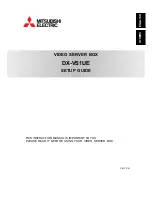
LSI Corporation
- 38 -
12Gb/s MegaRAID SAS Software User Guide
March 2014
Chapter 2: Introduction to RAID
RAID Availability
Table 17 RAID Levels and Capacity
2.4
RAID Availability
2.4.1
RAID Availability Concept
Data availability without downtime is essential for many types of data processing and storage systems. Businesses
want to avoid the financial costs and customer frustration associated with failed servers. RAID helps you maintain data
availability and avoid downtime for the servers that provide that data. RAID offers several features, such as spare
drives and rebuilds, that you can use to fix any drive problems, while keeping the servers running and data available.
The following subsections describe these features.
Spare Drives
You can use spare drives to replace failed or defective drives in a drive group. A replacement drive must be at least as
large as the drive it replaces. Spare drives include hot swaps, hot spares, and cold swaps.
A hot swap is the manual substitution of a replacement unit in a disk subsystem for a defective one, where the
substitution can be performed while the subsystem is running (performing its normal functions). The backplane and
enclosure must support hot swap for the functionality to work.
Hot spare drives are drives that power up along with the RAID drives and operate in a Standby state. If a drive used in
a RAID virtual drive fails, a hot spare automatically takes its place, and the data on the failed drive is rebuilt on the hot
spare. Hot spares can be used for RAID levels 1, 5, 6, 10, 50, and 60.
RAID
Level
Capacity
0
RAID 0 (striping) involves partitioning each drive storage space into stripes that can vary in size. The combined storage space is
composed of stripes from each drive.
RAID 0 provides maximum storage capacity for a given set of drives. The usable capacity of a RAID 0 array is equal to the number of
drives in the array into the capacity of the smallest drive in the array.
1
With RAID 1 (mirroring), data written to one drive is simultaneously written to another drive, which doubles the required data storage
capacity. This situation is expensive because each drive in the system must be duplicated. The usable capacity of a RAID 1 array is equal
to the capacity of the smaller of the two drives in the array.
5
RAID 5 provides redundancy for one drive failure without duplicating the contents of entire drives. RAID 5 breaks up data into smaller
blocks, calculates parity by performing an exclusive-or on the blocks and then writes the blocks of data and parity to each drive in the
drive group. The size of each block is determined by the stripe size parameter, which is set during the creation of the RAID set. The
usable capacity of a RAID 5 array is equal to the number of drives in the array, minus one, into the capacity of the smallest drive in the
array.
6
RAID 6 provides redundancy for two drive failures without duplicating the contents of entire drives. However, it requires extra capacity
because it uses two parity blocks per stripe. This makes RAID 60 more expensive to implement. The usable capacity of a RAID 6 array is
equal to the number of drives in the array, minus two, into the capacity of the smallest drive in the array.
00
RAID 00 (striping in a spanned drive group) involves partitioning each drive storage space into stripes that can vary in size. The
combined storage space is composed of stripes from each drive. RAID 00 provides maximum storage capacity for a given set of drives.
10
RAID 10 requires twice as many drives as all other RAID levels except RAID 1.
RAID 10 works well for medium-sized databases or any environment that requires a higher degree of fault tolerance and
moderate-to-medium capacity. Disk spanning allows multiple drives to function like one large drive. Spanning overcomes lack of disk
space and simplifies storage management by combining existing resources or adding relatively inexpensive resources.
50
RAID 50 requires two to four times as many parity drives as RAID 5. This RAID level works best when used with data that requires
medium to large capacity.
60
RAID 60 provides redundancy for two drive failures in each RAID set without duplicating the contents of entire drives. However, it
requires extra capacity because a RAID 60 virtual drive has to generate two sets of parity data for each write operation. This situation
makes RAID 60 more expensive to implement.
Summary of Contents for ThinkServer RD650
Page 1: ...ThinkServer 12 Gb s MegaRAID SAS Software User Guide ...
Page 417: ......
Page 418: ......
















































